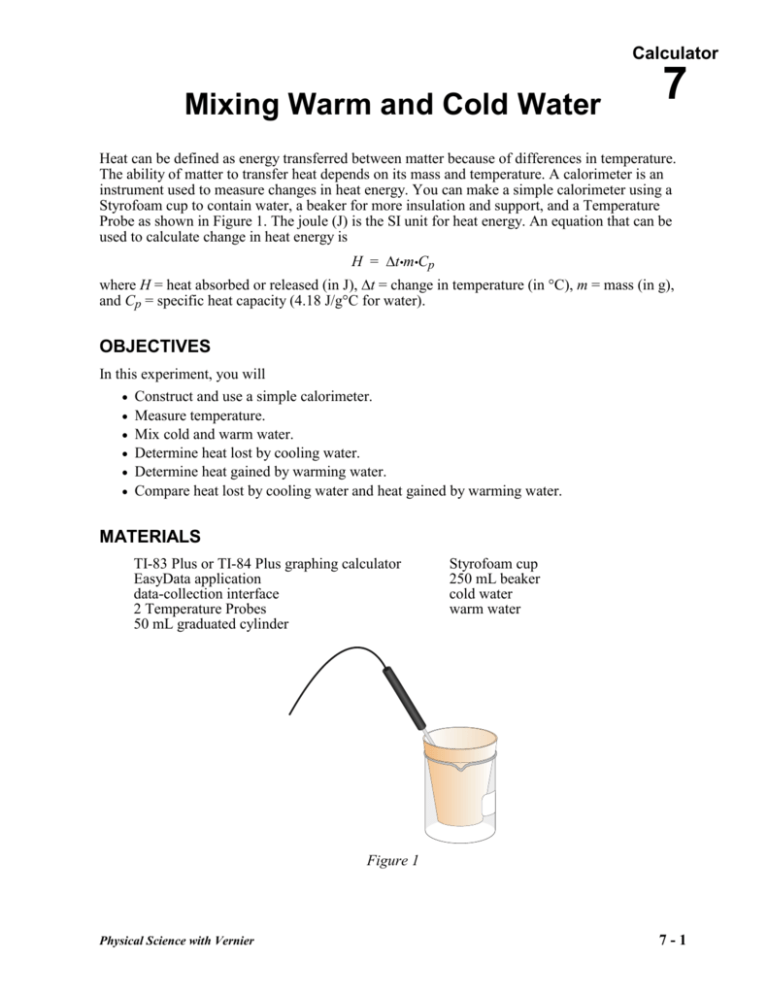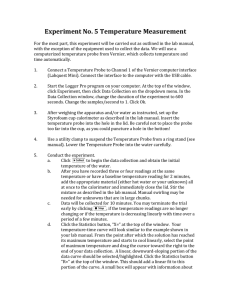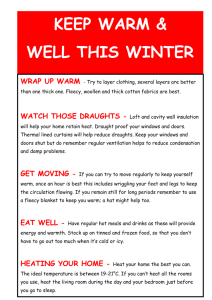Mixing Warm and Cold Water Lab
advertisement

Calculator Mixing Warm and Cold Water 7 Heat can be defined as energy transferred between matter because of differences in temperature. The ability of matter to transfer heat depends on its mass and temperature. A calorimeter is an instrument used to measure changes in heat energy. You can make a simple calorimeter using a Styrofoam cup to contain water, a beaker for more insulation and support, and a Temperature Probe as shown in Figure 1. The joule (J) is the SI unit for heat energy. An equation that can be used to calculate change in heat energy is H = t•m•Cp where H = heat absorbed or released (in J), t = change in temperature (in °C), m = mass (in g), and Cp = specific heat capacity (4.18 J/g°C for water). OBJECTIVES In this experiment, you will Construct and use a simple calorimeter. Measure temperature. Mix cold and warm water. Determine heat lost by cooling water. Determine heat gained by warming water. Compare heat lost by cooling water and heat gained by warming water. MATERIALS TI-83 Plus or TI-84 Plus graphing calculator EasyData application data-collection interface 2 Temperature Probes 50 mL graduated cylinder Styrofoam cup 250 mL beaker cold water warm water Figure 1 Physical Science with Vernier 7-1 Calculator 7 PROCEDURE 1. Obtain and wear goggles. 2. Turn on the calculator and connect it to the data-collection interface. Connect Temperature Probe 1 to Channel 1 and Temperature Probe 2 to Channel 2 of the interface. 3. Set up EasyData for data collection. a. b. c. d. e. f. g. Start the EasyData application, if it is not already running. Select from the Main screen, and then select New to reset the application. Select from the Main screen, then select Time Graph… Enter 2 as the time between samples in seconds. Select . Enter 45 as the number of samples and select . Data collection will last 90 seconds. Select to return to the Main screen. 4. Place a Styrofoam cup into a 250 mL beaker as shown in Figure 1. Use a 50 mL graduated cylinder to get 50.0 mL (50.0 g) of cold water from the container supplied by the teacher. Be careful not to take any ice pieces. Pour the cold water into the Styrofoam cup and insert Probe 1. 5. Use a 50 mL graduated cylinder to get 50.0 mL (50.0 g) of warm water from the container supplied by the teacher. Place Probe 2 into the warm water in the 50 mL graduated cylinder. After the probes have been in the cold and warm water for at least 30 seconds, you are ready to begin data collection. 6. Measure temperatures. a. After the probes have been in the liquids for at least 30 seconds, select to begin collecting temperature data. b. After the first temperature readings have been made, transfer the warm water and its probe to the Styrofoam cup. c. Stir to mix the warm water with the cold water. Continue stirring until data collection is finished. 7. When data collection is complete, a graph of temperature vs. time will be displayed. Use and to examine the data points along the curve for Probe 1. As you move the cursor right or left, the time (X) and temperature (Y) values of each data point are displayed above the graph. Record the maximum and minimum temperatures (round to the nearest 0.1°C). Use to switch the cursor to the curve of temperature vs. time for Probe 2 (warm water). Examine the data points along the curve. Record the maximum and minimum temperatures (round to the nearest 0.1°C). 7-2 Physical Science with Vernier Mixing Warm and Cold Water DATA Cold Water Probe 1 Warm Water Probe 2 MIN ______ °C MIN ______ °C MAX ______ °C MAX ______ °C PROCESSING THE DATA 1. Calculate the temperature change, t, for the warming of cold water and the cooling of warm water by subtracting the minimum temperature from the maximum temperature for each process (t = tmax – tmin). 2. Calculate the heat gained by the cold water (in J). Use the equation H = t•m•Cp where H = heat absorbed (in J), t = change in temperature (in °C), m = mass (50.0 g in this experiment), and Cp = specific heat capacity (4.18 J/g°C for water). 3. Calculate the heat lost by the warm water (in J). 4. Calculate the percent difference using the formula % difference = heat lost – heat gained X 100 heat loss 5. What are some factors that might have caused the difference determined in Step 4? Physical Science with Vernier 7-3 Calculator 7 EXTENSION 1. Build and test a better calorimeter that might reduce heat lost in this experiment. 7-4 Physical Science with Vernier








